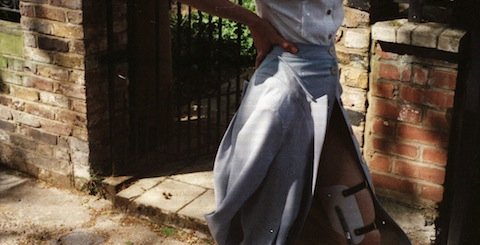
Orthopaedics of Fashion
24/04/2012
The promising Lithuanian fashion designer Eglė Čekanavičiūtė (1986) studied at the Academy of Arts in Vilnius and graduated from Central Saint Martin’s College in London; she started to shape her own style and created her own fashion label, Artefact, while her professional experience has been tied to such fashion houses as Burberry and Christian Dior. Currently, Čekanavičiūtė is continuing to challenge herself in Paris, working under the Belgian conceptual fashion label, Maison Martin Margiela.
At the end of March, the Vilnius fashion and art festival Mados Infekcija 2012 featured two collections by the young fashion designer. The asymmetrical silhouettes of the collection titled, “It's All Around You”, were accessorized with orthotics that had been raised to a new, aesthetic level – metal orthoses and thick, orthopaedic soles. The designer's second collection, “Seed”, surprised everyone: real, living plants – naturally and completely oblivious to their surroundings – were growing out of clothes made from organic materials and fashioned into minimalistic cuts.
In the first collection, the designer broke the stereotypes on what is considered either beautiful or ugly through the illustration of traits shared between orthotics and the process of clothes creation; in the second, she reminded us of the weakness of humans when faced the power of nature. Eglė Čekanavičiūtė transforms the body into a masterpiece and highlights the personality, ensuring comfort in terms of both the physical and the psychological.
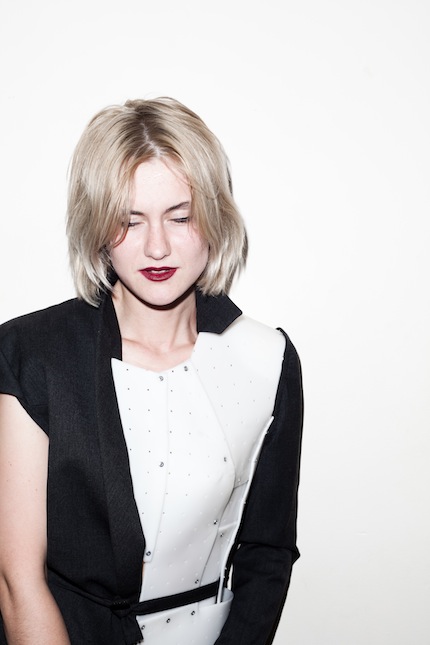
Egle Čekanavičūte. Photo: Rokas Darulis
You are the 4th generation of a family involved in fashion. How was it growing up in an environment full of art and fashion? Have your childhood and family roots helped you to succeed in the fashion world? Do you feel it's like a bonus, when comparing yourself to newcomers in the field?
It is true that I come from a family of tailors and musicians. It surely made a great impact on my personality, interests and development, and helped shape my career. It also served me well concerning basic skills, as I knew how to sew and make patterns for some time already before enrolling in fashion school. I think it is a big advantage to have a background, but it's not everything. One must be hard-working and open to the learning of new techniques.
You graduated from the Academy of Arts in Vilnius and from Central Saint Martin’s College in London, one of the most notable design schools in Europe. How has education helped prepare you for working in the industry?
The aim of every design school is, firstly, to teach design, and second, how to do research and how to make a garment; not necessarily how to make a business out of it. This was also my case – at these great schools, I had the chance to learn all about design, and I started to shape my own style, whereas working in the industry taught me how to apply creative knowledge to a business. It was very different from what I had imagined.
During your professional life, you have had the great opportunity to work with two striking, but completely different, well-known fashion phenomena - Christian Dior and the Belgian conceptualist, Maison Martin Margiela. What is your general impression of both?
These two houses are as different as black and white. But they both have a common purpose – to make their clients feel beautiful and special. In my opinion, this should be the main goal for all fashion designers who wish to be successful.

Artefact collection “Seed”. Photo: Egle Xiapin
How has this experience of working with such big fashion labels changed your way of thinking about fashion? Has this experience changed your way of working?
The experience at Christian Dior was very different from the one I'm having at the moment at Maison Martin Margiela, but they both were amazing challenges in my life, enriching me in different ways both as a designer and as a person. At Dior, there was a lot of shiny glamour – we were designing dreams. At Martin Margiela, we get much more into the essence of clothes, and that is what interests me the most at the moment. However, I am happy to have learned to be diverse and to apply my skills, regardless of where I work.
I read somewhere that the reclusive Martin Margiela has never made a personal appearance on the catwalk at the end of his fashion shows. Nor has he provided interviews to the press. Any attempt to obtain a photograph of him will be just as fruitless. Instead, he will send you a group photo of himself together with his entire work team. How do you describe the working environment there?
Martin never really wanted to blow a bubble out of his image, which was a very fashionable thing to do at the time of his debut. On the contrary, he always stressed the importance of his team, saying that he couldn't achieve these results on his own, and that the clothes should speak for themselves. I find it very beautiful. Even though Martin has left, the ambiance and concept of work in the house is much the same. The building containing our headquarters, which is located in a not-very-glamorous part of Paris, is old and shabby, but beautiful and cozy, and has a special mood. All the designers, as well as our creative director (who has, in fact, always been Martin's right hand) are kind, simple and down-to-earth people; we are all like a family – that happens rarely at other fashion houses.
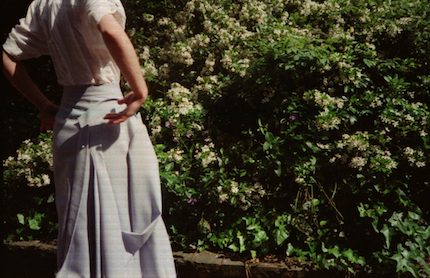
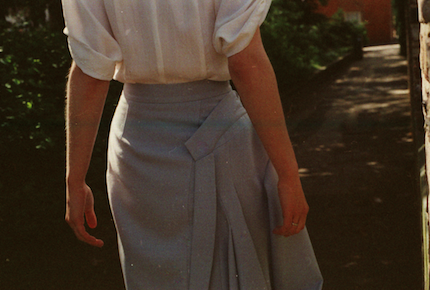
Today, fashion has become a global industry; even designers are rotating between different fashion houses. What is your opinion about globalization’s impact on fashion?
What sells best today is new, fresh visions. That is why all the big labels are also regularly "updating" their creative minds. It might sound cruel and inhumane, but this is the reality, and it applies to many industries, not only fashion.
Globalization serves design by giving the ability to travel easily, and to do different parts of design in different places of the world – where it can be done best. I am not defending child labor in China – I am relating more to the fact that today, designers can travel for research, enrich and refresh their minds, get inspired and bring good emotions and ideas to the company that they work for. Also, the ability to source top-quality tweed in England, having access to meticulous leather manufacturers in Italy, and getting your embroidered pieces beautifully done in India – all of these different parts of production are the traditions of these countries, and it allows them to sell their product / services as well.
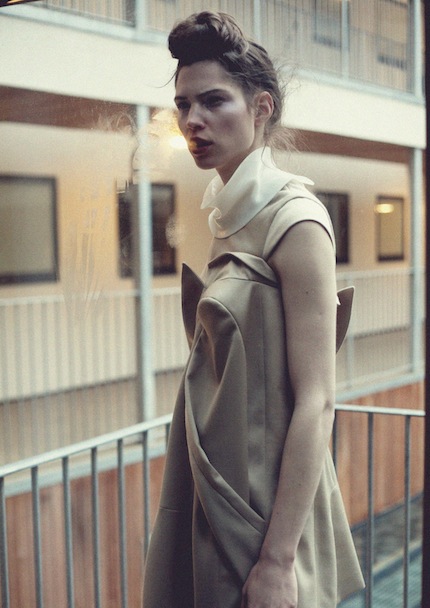
Artefact collection “It’s All Around You”. Photo: Rokas Darulis and Abie Lamin
The other side of the coin, however, is that "easy" traveling leads to an increase in CO2 emissions and harming the environment, which is not cool.
Five countries have established an international reputation in fashion: France, Italy, the United Kingdom, the United States and Japan. Who will be the next?
Scandinavian Fashion. Well, it already has established its reputation…
“Fashion as art and the fashion designer as artist” – what is your view on this statement?
So far, not all fashion is art, and even when it is, it's also a function.
When we do feel more appreciation for fashion as a medium that is transmiting a message, rather than just being clothes, then we call it art. However, this maxim sometimes is overestimated and used in a wrong sense. It has become very trendy for designers to call themselves artists, as this new label kind of elevates them, and it sounds divine. But I, personally, think that there are not that many good artists of fashion. I must add here that I prefer great craftsmanship over average “fashion art".
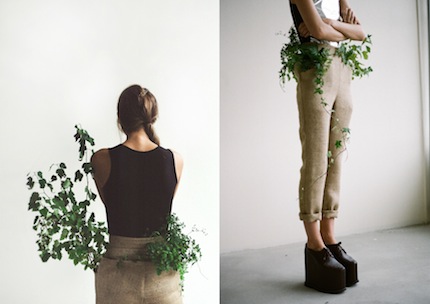
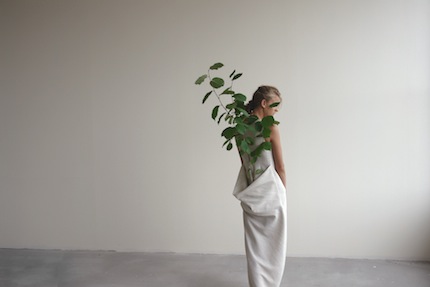
Artefact collection “Seed”. Photo: Egle Xiapin
What attracts you to fashion, as both a medium and as a mode of expression?
The fact that it is a way to turn a human body into a masterpiece and a way to help express one's personality.
How about your creative freedom? How does designing your own label differ from working for a large corporation?
It is very different. I am totally free as a designer for my label, Artefact, since I work on my own. I design a collection when I have something to say to the world, and I make clothes for individual people when I have orders. Sure, this kind of "business" does not guarantee you bread for tomorrow, but this is why I design for other brands in parallel. Of course, I also do that to gain experience and knowledge.
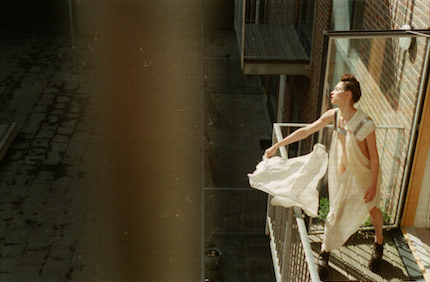
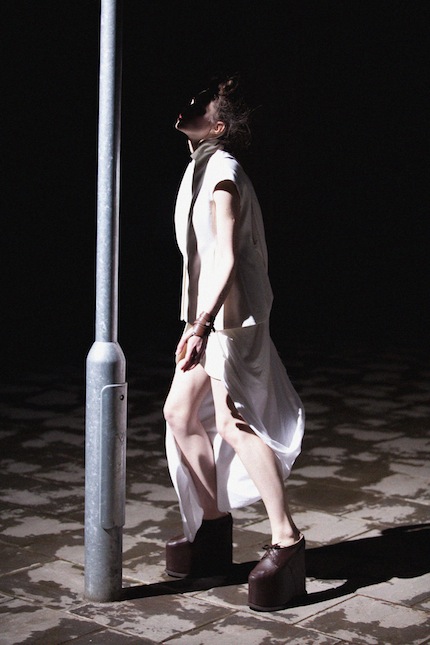
Artefact collection “It’s All Around You”. Photo: Rokas Darulis and Abie Lamin
What is the most difficult part of running your own label (e.g., design, production, sales, finance, and advertising)?
Balancing it all, I guess. For the moment, my label is just me and my ideas, without any responsibilities to others; therefore, I can avoid many of the complicated parts. I do the production at my mother's studio, with one seamstress, and of course, with the precious help of my mother; for now, it serves my needs. But if the business grows one day, I will have to deal with those other parts, which can be fun, too.
As for advertising - I think it all depends on the vision of the designer. When Margiela just started off, they did not do any advertising at all, and yet somehow managed to form a clientele and become well-known. Of course, you can't be grand if you don't do advertising – but do you have to? I prefer natural advertising – when people spread the word based on their own experience – it's more honest.
When you create something, what goes through your mind?
It is always a clash of images and sounds, colors and shapes, spaces and faces, moods and emotions, personal experiences and political ideas. Everything has to be digested and well-organized to look good, make sense, and make an impact.
What is your way of working? Do you sketch your ideas on paper, or do you drape fabric on a dress form?
Both. It usually starts with the research. Or stumbling across an image / film / object that carries me into a special mood. Most of the time, I first note the idea with random words in my notebook (sometimes my phone, if there's no notebook at hand); then comes the sketch; then draping / pattern cutting and so on. Sometimes a design is born by accident.
What is the most appropriate way to dress right now?
The way that expresses one's character best and makes one feel comfortable – both physically and psychologically.
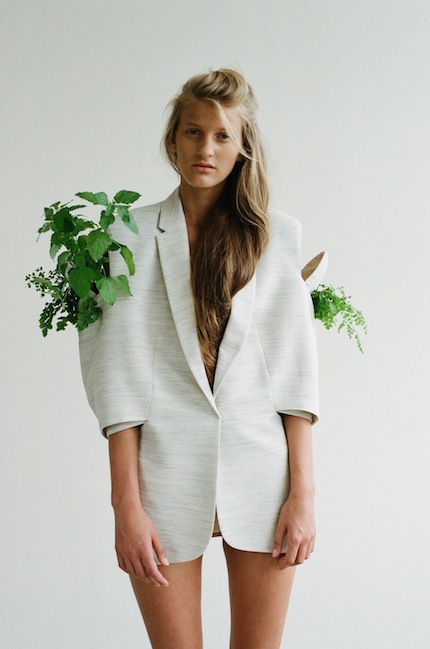
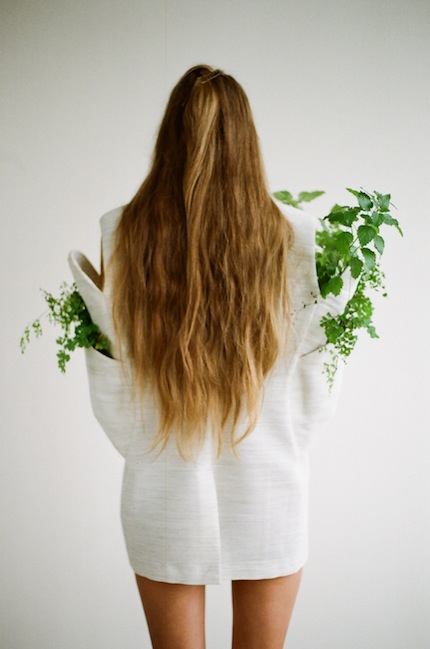
Artefact collection “Seed”. Photo: Egle Xiapin
Your collection, “Seed” (2011), is built-up and styled following the obvious conclusion that any human creation is helpless against the power of nature. We are experiencing a time right now during which changes in climate and nature are occurring – there are countless discussions about the coming apocalypse. Does this affect fashion?
Well, if there will be an apocalypse, nobody will need fashion. So, we should think and try to do our best while changes can still be made. The fashion industry of today is driven by consumerism and the throw-away culture; most of it is not ethical and not sustainable, and it is severely harming the environment. Therefore, instead of running the rat race, we should think of tomorrow and “what if nature strikes back?” This is what I wanted to say through "Seed".
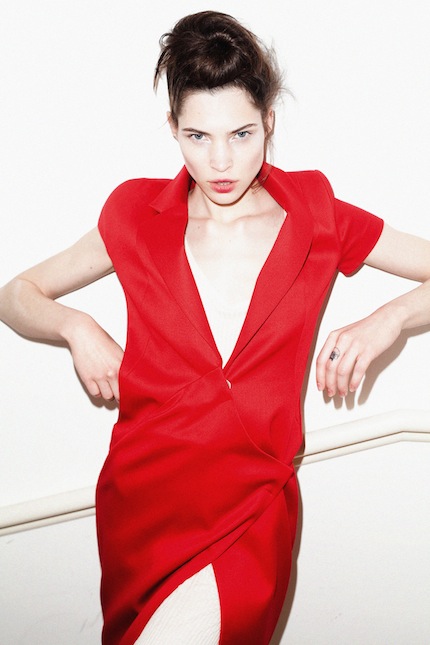
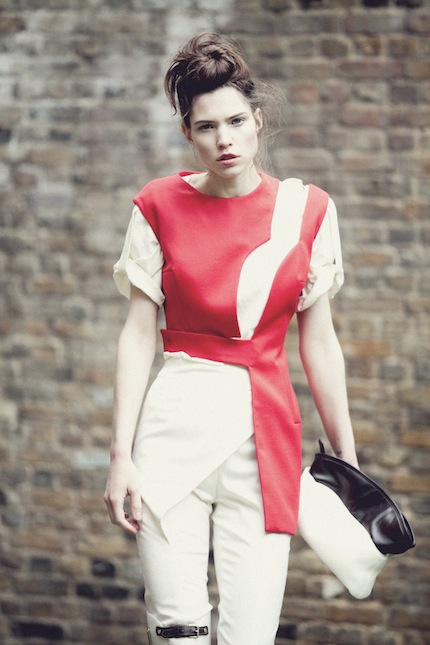
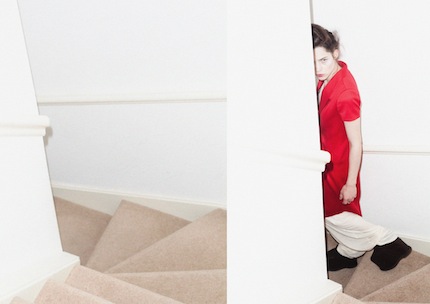
Artefact collection “It’s All Around You”. Photo: Rokas Darulis and Abie Lamin
Your collection, “It’s All Around You” (2010), shows the barrier between the healthy and the handicapped, the socially accepted and the unaccepted. With this collection, you tried to explain that orthopaedics and tailoring actually strive towards the same thing – fitting the body into the “right” shape.
But if we move aside all the reality – such as medicine and clinics – how would you describe the relationship between fashion and such artificial auxiliaries like dental braces, color contact lenses, corsets, push-up bras, super high heels, etc.? Aren’t there sometimes situations when fashion creates and makes claims for things that aren't actually necessary for people?
Ever since the human race stepped into some sort of civilization, they have had an image of beauty that was relevant for that moment. It has been changing over the years, until it became ridiculously strict around the 17th century, when harming your health was necessary to meet the beauty requirements of the day. The corset was an obligatory part of woman's dress for 400 years, up until the 20th century.
Happily, today we are free to wear anything we want, at least where it concerns the law – as long as one has his/her private zones covered (or partially covered...). However, the pressure from the beauty industry is so strong, that most people still feel obliged to wear clothes or shoes that they would never wear otherwise. The industry is bearing more and more fashion victims who consider appearance the only way of self-expression; who lavish the image, but forget about the rest. Perfection does not exist in nature, but we are constantly being brainwashed by the media and the industries, so we forget it, and we begin to feel ashamed of the reality.
Isn’t there a return to the “era of uncomfortable fashion” going on?
I think there is still a good dose of the health and "comfort" business, which seems to be growing faster than the beauty business. More and more people have started using terms like "quality of life", and luxury is becoming more comfort-based.
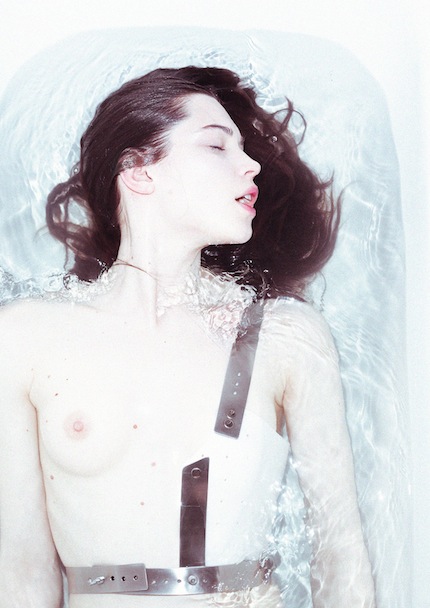
Artefact collection “It’s All Around You”. Photo: Rokas Darulis and Abie Lamin
Perhaps you can tell us something about your future collections, or other creative plans?
Time will tell.
How would you comment on Mados Infekcija 2012?
It was a beautiful event, organized by enthusiastic and caring people. It left me with some great memories, valuable contacts, and fancy catwalk pictures. Fashion is becoming more and more important to Lithuanians; the space was full of young, curious people. I'm not sure if everybody got my point, but I felt different forms of appreciation.